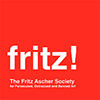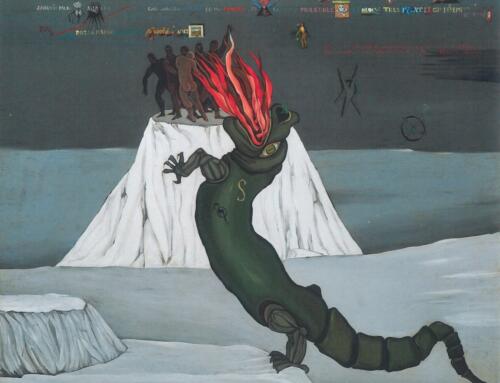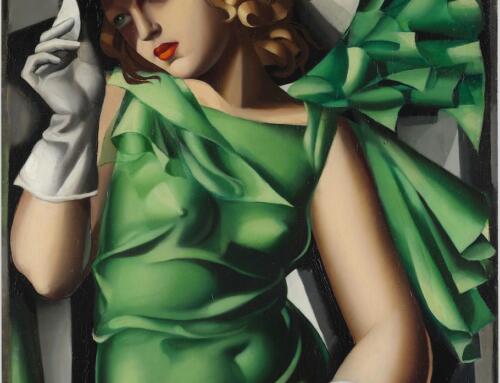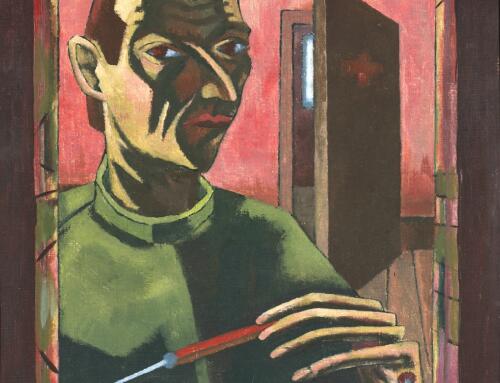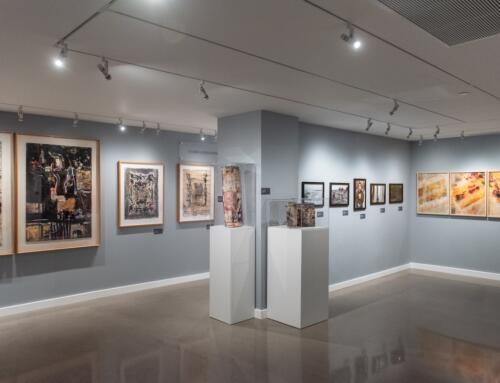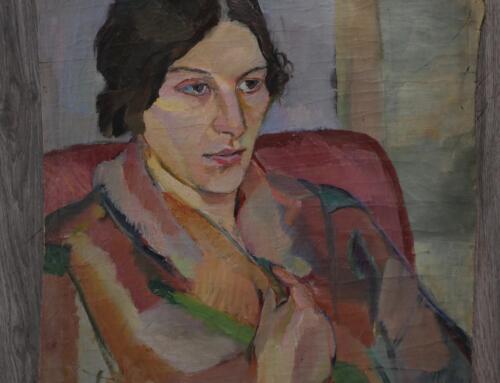Dear Friends,
February is a busy month with many interesting events in our orbit, starting with two film screenings at the JCC Manhattan, continuing with a virtual conversation with author Melvin Bukiet and a presentation of Fritz Ascher’s art, and two exhibitions, of which one is closing in early March in Germany, and one just opened in Portland, Oregon.
Please join us at the JCC Manhattan for two important film screenings:
As always, our online events can be accessed by everyone, free of charge:
WEDNESDAY, FEBRUARY 12, 12:00PM ET
SIGNS AND WONDERS.
A Conversation between
Author Melvin Jules Bukiet and Artist David Stern

Join us for a conversation between acclaimed author Melvin Jules Bukiet and renowned artist David Stern, marking the 25th anniversary of the publication of Signs and Wonders. Published in 1999, Bukiet’s novel tells the story of twelve prisoners on a barge in the late 20th century, freed by a violent storm and embarking on a symbolic pilgrimage through Germany as the millennium approaches. As their journey unfolds, their leader, Ben Alef, is seen by some as the next Messiah—invoking powerful themes of hope, identity, and transcendence.
In this conversation, Bukiet and Stern will delve into Bukiet’s books and explore the relationship between art and reality—does art need to reflect lived experiences to be authentic? How do personal histories shape creative work?
Melvin Jules Bukiet has published eleven books, including After, Signs and Wonders and Strange Fire. His fiction has appeared in the Paris Review and other magazines, his non-fiction in the American Scholar and other magazines. He teaches at Sarah Lawrence College and lives in New York City.
David Stern is a German born American figurative painter, whose work is rooted in the European figurative tradition and informed by American Abstract Expressionism. Stern’s art explores the human condition. With a career spanning over 45 years, his works have been exhibited internationally and can be found in public and private collections across the United States, Europe, and Asia.
Thank you, Richard Quinlan, for inviting me to give this presentation:
THURSDAY, JANUARY 27, 12:00PM EST
LOVE AND BETRAYAL.
THE GERMAN-JEWISH ARTIST FRITZ ASCHER (1893-1970)
A presentation by Rachel Stern, New York (NY),
organized by Saint Elizabeth University, Morristown (NJ)

Fritz Ascher, Male Portrait in Red, c. 1915. Private collection © Bianca Stock
Rachel Stern will present insights into the art and life of the German-Jewish artist Fritz Ascher and the mission of The Fritz Ascher Society for Persecuted, Ostracized and Banned Art. Introduced by Richard Quinlan, Director of the Center for Holocaust and Genocide Education at Saint Elizabeth University in Morristown (NJ).
Fritz Ascher (1893-1970), a painter, graphic artist, and poet, was recommended to the art academy in Königsberg by the renown German painter Max Liebermann at the age of 16. From 1913 onwards, he gained recognition as a painter in Berlin. Ascher was a keen observer of his era; the devastation of World War I and the revolutionary turmoil in Berlin inspired him to explore Christian and mystical themes, which he reinterpreted in innovative ways. Following the rise of the Nazi regime in 1933, the Jewish-born artist faced a ban on creating, exhibiting, and selling his work. During the pogroms of November 9/10, 1938, he was arrested and subsequently interned in the Sachsenhausen concentration camp and the Potsdam Gestapo prison.
Ascher survived the Shoah, finding refuge from 1942 in a cellar in Berlin-Grunewald. During these harrowing and isolating years, he composed poetry. Post-1945, Ascher developed a distinctive artistic style, drawing inspiration from the nearby Grunewald, focusing on landscapes while remaining faithful to his expressionist visual language. He lived a reclusive life until his passing on March 26, 1970.
Rachel Stern is the Executive Director of the Fritz Ascher Society for Persecuted, Ostracized and Banned Art in New York. She emigrated to the USA in 1994, wrote for AUFBAU and worked for ten years in the Department of Drawings and Prints at the Metropolitan Museum of Art in New York. Most recently, she co-organized with with Jutta Götzmann, Executive Director of the Museums of the City of Freiburg, the exhibition “Love and Betrayal. The Expressionist Fritz Ascher from New York Private Collections,” on view until March 2nd at Haus der Graphischen Sammlung in Freiburg im Breisgau, Germany, and co-edited the exhibition catalogue that accompanies the exhibition (Petersberg: Michael Imhof Publishers 2024).
The event is organized by Saint Elizabeth University in Morristown (NJ) and co-sponsored by The Fritz Ascher Society in New York (NY).

LOVE AND BETRAYAL – The Expressionist Fritz Ascher from New York Private Collections is on view until March 2, 2025 at Haus der Graphischen Sammlung in Freiburg im Breisgau, Germany.
Influenced by the horrors of the First World War and the revolutionary unrest, the Expressionist Fritz Ascher (1893–1970) turned to Christian-spiritual themes, which he radically reinterpreted. From 1916 onwards he dealt with the theme of love and betrayal in intimate drawings. Impressive poems complement early charcoal, graphite and ink drawings as well as colourful gouaches with deep emotionality.

MODERN TIMES – Pictures of the 1920s is on view until February 16, 2025 at Museum für Neue Kunst in Freiburg im Breisgau, Germany.
The traumas of war, revolution and political radicalisation, democracy, women’s suffrage, freedom and individuality, abject poverty and unbridled wealth: the 1920s was an era brimful of contradictions and supposed incongruities. Works by Otto Dix, Conrad Felixmüller, George Grosz, Käthe Kollwitz or Elisabeth Voigt reflect various facets of life during the interwar period – on the streets, in the factories, in cafés and the cabarets. Above all, they focus on those people who were on the lowest rung of society’s ladder.
This year marks the 80th anniversary of the liberation of Auschwitz. We can’t imagine a better way of commemorating this important anniversary than celebrating with an exhibition of the art of Alice Lok Cahana, one of the few survivors of this unimaginable hell on earth, and the family she raised:
SURVIVAL AND INTIMATIONS OF IMMORTALITY:
The Arts of Alice Lok Cahana,
Rabbi Ronnie Cahana and Kitra Cahana
Oregon Jewish Museum and Center for Holocaust Education, Portland, OR
January 26 – May 25, 2025

This unique and powerful exhibition explores the role of art and creativity, bringing the past into the present by focusing on three generations of artists from the same family. Alice Lok Cahana (1929-2017) was a Holocaust survivor who pledged she would become an artist if she survived the war. Rabbi Ronnie Cahana, Alice’s oldest son, is a poet and survivor of a major stroke. Kitra Cahana, Ronnie’s oldest daughter, is a filmmaker and photographer.
The presentation reveals how the tragedy of the Holocaust impacted multiple generations of a family and how each member transformed the destructive trauma of the Shoah into acts of intense creative accomplishment, taking their own path to provide a through-line to preserving the memories, culture, and identity of their shared family and the Jewish people.
Survival and Intimations of Immortality is curated by Ori Z Soltes and co-organized by Rachel Stern, both co-founders of The Fritz Ascher Society for Persecuted, Ostracized and Banned Art in New York.
And Portland is just the beginning for this international traveling exhibition!
We recorded our two spectacular January virtual events, and you can watch them here:
February is the last month for the Fritz Ascher exhibition in Freiburg (see above), as well as these not-to-be-missed exhibitions, which include unknown artists who were persecuted or murdered by the German Nazi regime:

Make Way for Berthe Weill. Art Dealer of the Parisian Avant-Garde is on view until March 1, 2025 at The Grey Art Museum in New York, NY.
Berthe Weill was a trailblazing art dealer who exhibited works by emerging artists in her Parisian gallery from 1901 to 1941. Even though many of them went on to become key avant-garde figures, Weill’s role has been omitted from most historical accounts of 20th-century modernism. In this presentation, Lynn Gumpert, a co-curator of the first exhibition on Weill, provides an overview of this remarkable woman.

ELSE MEIDNER (1901-1987). Melancholia is on view until March 2, 2025 at the Jewish Museum Frankfurt, Germany.
Portraits and self-portraits constitute a large part of painter and illustrator Else Meidner’s oeuvre. In many of these works, the artist uses gestures to subtly heighten the intensity of expression. In particular, the gesture of melancholy — with subjects resting their heads in their hands — carries throughout her entire body of work. The portraits oscillate between meditative contemplation, resignation, and grief.
Please donate generously to make our work possible. THANK YOU.
The Fritz Ascher Society is a not-for-profit 501(c)3 organization. Your donation is fully tax deductible.
I look forward to seeing you this month, and to hearing about your thoughts and ideas. And please visit our website – it is just so full of information!
My best wishes,
Rachel Stern
Executive Director
